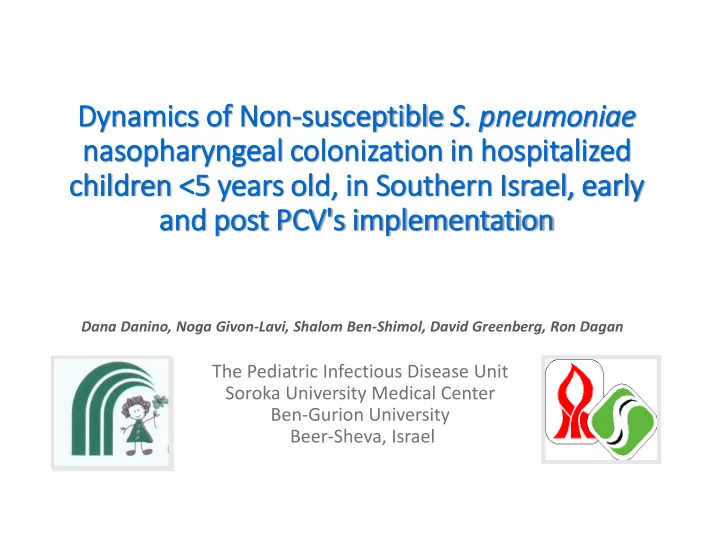

Dyn ynamics of Non-susceptib ible le S. . pneumoniae nasopharyngeal colo lonization in in hospit italized child ildren <5 5 years old ld, , in in Southern Is Israel, , early ly and post PCV's 's im imple lementation Dana Danino, Noga Givon-Lavi, Shalom Ben-Shimol, David Greenberg, Ron Dagan The Pediatric Infectious Disease Unit Soroka University Medical Center Ben-Gurion University Beer-Sheva, Israel
Disclosure + No, nothing to disclose Yes, please specify: Ownership/ Honoraria/ Consulting/ Funded Royalties/ Stock Other Company Name Equity Employee Expenses Advisory Board Research Patent Options (please specify) Position
Pneumococcal nasopharyngeal colonization Site of potential Port of entry for Source of acquisition of mucosal and transmission antibiotic invasive infections resistance Children < 5 years are the main carriers, and thus also the main transmitters
PCVs impact on pneumococcal carriage VT13 Non VT13 Within-serotype (Replacement) nonsusceptibility (Continuous antibiotic pressure) +/- ? Overall carriage
Methods • An ongoing, prospective, population-based, active surveillance, one hospital serving the entire population • Vaccination program and Vaccine uptake ≥ 2 doses PCV7- PCV7 - PCV13- private NIP + NIP market catch-up NIP= national immunization program • Every working day, 8 children <5 years, visiting the pediatric emergency room were enrolled, since Nov 2009 • Methodology of nasopharyngeal cultures, microbiology, serotyping and susceptibility testing were previously described ( Dagan et al, JID, 211:1144, 2015, Human Vaccine Immunother , 12(2): 268-276,2016 )
Antibiotic non-susceptibility rates between VT13 and non-VT13 carried serotypes prior to the impact of PCVs (07/2009-06/2010) VT13 serotypes (n=318) Non VT13 serotypes (n=261) % <0.001 % <0.001 % % of all positive cultures % <0.001 % <0.001 <0.001 % <0.001 % % % S= susceptible, Pen= penicillin, Ery= erythromycin, Clind= clindamycin
Dynamics of pneumococcal carriage, 2009 - 2015 PCV13 PCV 13 PCV7 PCV PCV PCV7 NIP private NIP + market catch-up Over erall all Pneumococcal car neumococcal carria riage ge % (n= (n=4,166) % <0.001* Non VT Non VT13 13 ser eroty otypes pes % % of all cultures (n= (n=2,962) ) <0.001* % % VT13 serotypes (n=1,204) % <0.001* %
Antibiotic non-susceptibility rates: all non-VT13 serotypes (N=2,962) 2009-10 2014-15 50 % 1.2 (1.0-1.4)* 40 % % of non-VT13 positive cultures 1.9 (1.4-2.5)* 30 % % 20 2.7 (1.6-4.3)* 1.6 (1.0-2.5)* 2.6 (1.5-4.3)* 2.6 (1.4-5.1)* % 10 % 0 S= susceptible, Pen= penicillin, Ery= erythromycin, Clind= clindamycin * Rate ratio (confidence intervals)
Dynamics in Non-susceptibility; 5 most common non-VT13 serotypes 2014-15 2009-10 15A 15B/C (n=178) (n=367) % % % of Non-VT13 positive cultures * % % % % * * * % % % % % % % % % 23B 16F 11A (n=202) (n=220) (n=160) * % % % % of Non-VT13 positive cultures * % % % * % % % % % % % % % % % % % % Pen= penicillin, Ery= erythromycin, Clind= clindamycin * =P value <0.05 ; trend in proportion for all years 2009-10 – 2014-15
Impact of PCV on overall non-susceptible pneumococcal carriage (N=8,537) 2009-10 2014-15 35 % 0.6 (0.6-0.7)* 30 % 25 % 0.7 (0.6-0.8)* % of all cultures 20 % 0.6 (0.5-0.7)* % 0.6 (0.5-0.7)* 15 0.7 (0.6-0.8)* 0.5 (0.4-0.7)* % 10 % 5 % 0 Pnc= pneumococcal, S= susceptible, Pen= penicillin, Ery= erythromycin, Clind= clindamycin * Rate ratio (confidence intervals)
Conclusions o PCVs impact on non-susceptible pneumococcal carriage, is derived from 4 different components: VT13 v Overall carriage v Non-VT13 Intra-serotype non-susceptibility o PCV7/PCV13 introduction to the Israeli national immunization program reduced non-susceptible pneumococcal carriage from first to sixth year o Non-responsible overuse of antibiotics is still prevalent and an ongoing risk for rebound of antibiotic resistance among pneumococci
Recommend
More recommend